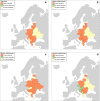Epidemiology of taeniosis/cysticercosis in Europe, a systematic review: eastern Europe
- PMID: 30376899
- PMCID: PMC6208121
- DOI: 10.1186/s13071-018-3153-5
Epidemiology of taeniosis/cysticercosis in Europe, a systematic review: eastern Europe
Erratum in
-
Correction to: Epidemiology of taeniosis/cysticercosis in Europe, a systematic review: eastern Europe.Parasit Vectors. 2019 Feb 18;12(1):84. doi: 10.1186/s13071-019-3328-8. Parasit Vectors. 2019. PMID: 30777134 Free PMC article.
Abstract
Background: Taenia solium and Taenia saginata are food-borne parasites of global importance. In eastern Europe only fragmented information is available on the epidemiology of these zoonotic parasites in humans and animal populations. In particular for T. solium, on-going transmission is suspected. The aim of this systematic review was to collect the available data and describe the current knowledge on the epidemiology of T. solium and T. saginata in eastern Europe.
Methods: Literature published in international databases from 1990 to 2017 was systematically reviewed. Furthermore, local sources and unpublished data from national databases were retrieved from local eastern European experts. The study area included 22 countries.
Results: Researchers from 18 out of the 22 countries provided data from local and unpublished sources, while no contacts could be established with researchers from Belarus, Kosovo, Malta and Ukraine. Taeniosis and human cysticercosis cases were reported in 14 and 15 out of the 22 countries, respectively. Estonia, the Former Yugoslav Republic of Macedonia, Lithuania, Moldova, Poland, Romania, Serbia, and Slovakia reported cases of porcine cysticercosis. Croatia, Czech Republic, Estonia, Former Yugoslav Republic of Macedonia, Moldova, Poland, Romania, Serbia, Slovakia, and Ukraine reported bovine cysticercosis.
Conclusions: There is indication that taeniosis and cysticercosis are present across eastern Europe but information on the occurrence of T. solium and T. saginata across the region remains incomplete. Available data are scarce and species identification is in most cases absent. Given the public health impact of T. solium and the potential economic and trade implications due to T. saginata, notification of taeniosis and human cysticercosis should be implemented and surveillance and notification systems in animals should be improved.
Keywords: Bovine; Eastern Europe; Epidemiology; Neurocysticercosis; Porcine; Taenia saginata; Taenia solium.
Conflict of interest statement
Ethics approval and consent to participate
This work is a collaboration within the framework of CYSTINET, the European network on taeniasis/cysticercosis, COST ACTION TD1302.
Consent for publication
Not applicable.
Competing interests
The authors declare that they have no competing interests.
Publisher’s Note
Springer Nature remains neutral with regard to jurisdictional claims in published maps and institutional affiliations.
Figures






References
-
- FAO/WHO . Multicriteria-based ranking for risk management of food-borne parasites. Microbiologial Risk Assessment Series No. 23. Rome: FAO/WHO; 2014.
-
- Torgerson PR, Devleesschauwer B, Praet N, Speybroeck N, Willingham AL, Kasuga F, et al. World Health Organization estimates of the global and regional disease burden of 11 foodborne parasitic diseases, 2010: a data synthesis. PLoS Med. 2015;12:e1001920. doi: 10.1371/journal.pmed.1001920. - DOI - PMC - PubMed
Publication types
MeSH terms
Grants and funding
LinkOut - more resources
Full Text Sources

